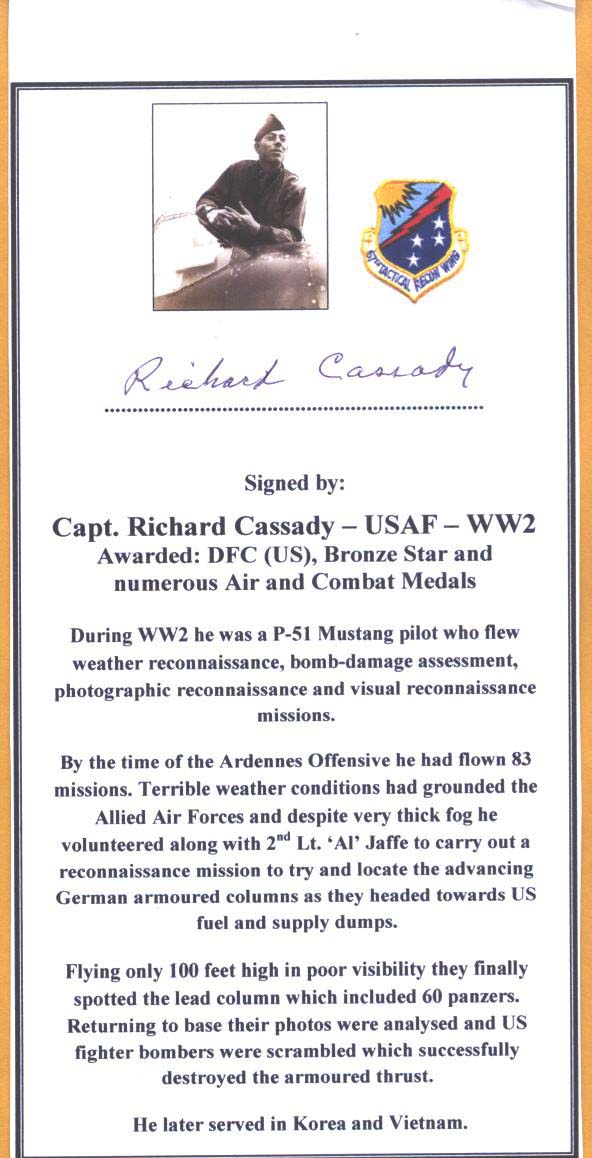
|
~SOLD~ CASSADY Richard
Pleased to offer some unique items from a friend of mine who is lucky enough to work with many of the veterans on behalf of military artists, book publishers and documentary makers.Glossy book plate / card with biographical details
Decorated veteran flies again for first time in 50 years
Published: Monday, November 07, 2011, 7:30 AM
MOBILE, Alabama — At age 88, retired USAF pilot Richard Cassady recently got the chance after 50 years to take the controls of an airplane, thanks to Jack Thomas, a man he didn't even know.
A decorated career military man and reconnaissance pilot whose heroism was detailed in a Time Magazine article on Jan. 15, 1945, Cassady served his country during World War II, the Korean War and Vietnam.
Cassady fell in love with flying when he was a child in Nashville, Ark. "I saw my first airplane — a crop duster — when I was 4 years old," he said. "I said then, 'That's what I am going to do, fly an airplane.'"
In January 1942, a month after the U.S. entered World War II, Cassady joined the Army Air Corps, later the U.S. Air Force.
His ultimate job was to fly his P51 Mustang single-engine fighter plane on weather reconnaissance, bomb-damage assessment, photographic reconnaissance and visual reconnaissance missions.
He took part in the offensive against the Siegried Line from September to December 1944, and in the Battle of the Bulge, December 1944 to January 1945.
His daring, heroic and successful recon mission in the Bulge was detailed in Time and later in books by "Tiger" Joe Thompson ("A Photographic Diary of World War II") and Major Harry Francks ("Winter Journey through the 8th").
In the Time article, the writer tells of the coming crisis as "a large German armored task force of tanks, tank destroyers, self-propelled guns and trucks snaked northward" to "seize U.S. gasoline and supply dumps just beyond Stavelot (Belgium) to cut in behind the communications and supply lines of the First and Ninth Armies."
If the Germans took tiny Stavelot, they'd be only 22 miles from Liege (Belgium), a vital U.S. supply point at the end of the line from Antwerp, the writer explains. If Liege fell, the U.S. would have to retreat from the whole Aachen-Duren area (the main fighting front during the Allied invasion of Germany).
Though U.S. tanks were on their way to meet the enemy, their arrival would take 40 hours, at least.
And in front of the advancing Germans "were only pathetic detachments of U.S. service troops, supply stevedores, civil-affairs officers, medics, clerks."
The immediate task was to get every fighter bomber into action, but those aircraft were deployed in other crucial actions. And anyway, there was slim hope that there would be any let-up of the week-long drizzle and a fog so heavy and low that "even the birds were walking," as one writer put it.
Though there was little chance a plane could get off the ground, a call went out for two volunteers "to take a long chance: To fly their speedy Mustangs into the soup, trying to locate the enemy's forces."
Enter Capt. Richard Cassady and 2nd Lt. Abraham Jaffe.
Cassady had flown 83 missions and was due for a rest. But the two volunteered for the reconnaissance mission, meaning they had to fly less than 100 feet above the floors of the narrow valleys to get a glimpse of the roads and what was on them.
And they spotted what they were looking for — a column headed by 60 German tanks and armored vehicles with their scores of trucks and guns.
The photos the men brought back allowed General Vandenberg's Ninth Army fighter bombers to destroy the advancing army. No German tank ever got far beyond Stavelot. The U.S. loss had been one plane.
In 1951, Cassady was in the Korean War; in the '60s, he served in the Vietnam War. Over the course of the three wars, he earned a multitude of medals and decorations, among them a Distinguished Flying Cross, a Purple Heart, a Bronze Star, numerous Air Medals and Combat Medals in all of the wars.
But after the Korean War, he never flew again.
However, one of his daughters, Becky Owens, had a friend, Gary Duerksen, who worked with a recreational flyer, Jack Thomas. And that connection gave Col. Cassady his chance to fly an airplane again on Aug. 6, 2011 — half a century after he served his country as a pilot.
"I've never known a World War II veteran who was also an aviator, so I was really excited about taking Mr. Cassady up," Thomas said. "When we took off (he flies a Cessna single-engine) and got leveled at 1,400 feet, just sightseeing around Dauphin Island, I let him take the controls, and after he got the hang of it, he did well."
Thomas read the Time magazine story about Cassady. "The word 'hero' is used a lot," he said. "But Mr. Cassady is a hero. His entire generation are true heroes and they deserve to be recognized as such."
-----
This story was written by Jo Anne McKnight, Press-Register Correspondent.
Glossy book plate / card with biographical details measuring 3 ¾” x 7 ¾”
Price: $0.00
Please contact us before ordering to confirm availability and shipping costs.
Buy now with your credit card
other ways to buy
|


